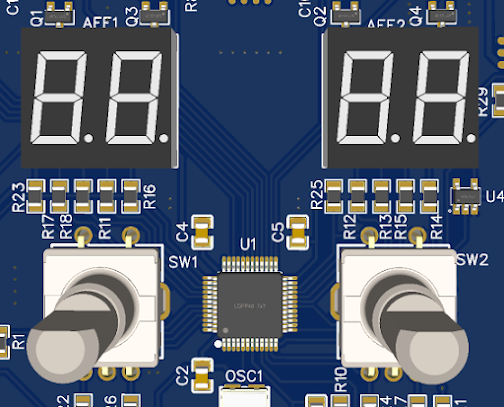It's been a few weeks since I posted anything. However, I worked on four simultaneous subjects.
- Troubleshooting the CSQ600.
- The development of the MIDI switch.
- The finalization of the USB keyboard converter for Omega.
- The test of the audio output of my future Drumulator.
CSQ-600:
Unfortunately, I couldn't get the machine to work. However, I installed a new processor, but the result is strictly identical to that of the original processor. I just managed to have a different start of the machine by replacing the original oscillator with a signal generator. The result is insufficient for me to get an idea of the problem for now. After a few days of intense investigation, I momentarily put the subject on hold.
MIDI SWITCH :
I made some progress on the subject. I mounted a module with four RJ45 inputs/outputs as well as a small conversion 'pod' to MIDI IN/OUT. I'm currently stuck because I can't get my hands on the small processor used on the PODs. Fortunately, I recently found availability for this processor and ordered a few copies. I am awaiting delivery.
USB KEYBOARD CONVERTER :
I am pleased to announce that the development of this interface is finished. I finalized the code for 'AZERTY' and 'QWERTY' type keyboards. As a reminder, this converter allows you to connect a standard USB keyboard to the MSX OMEGA microcomputer. Also, I'm waiting for some components to manufacture a few copies that I will make available for sale for those who wish to go through this solution rather than building the OMEGA keyboard entirely.
 |
| The Omega computer |
AUDIO OUTPUT FOR MY FPGA DRUMULATOR :
I completely coded the processor part as well as the waveform sequencer in VHDL. The goal is to fit as many logic elements of a Drumulator as possible within an FPGA. So I still had to study the audio output.
The problem is of course, that the kind of digital to analog converter used in the Drumulator is absolutely no longer available. The solution adopted therefore consisted in using an available 12-bit converter, and in coding the system making it possible to reproduce the logarithmic transfer function of the original converter.
For this, I started to mount a copy of my analog output prototype:
 |
| Quick & dirty test plateform but sound very good! |
To do my tests, I used a development board from STmicro equipped with a fairly powerful STM32 processor. This kind of board associated with the ST development software is really ideal. Once the system was set up, I encoded a square signal at 1KHz using Audacity which I exported in µ-LAW format to the development board. The result gives what was expected:
For this kind of test, low precision required and low frequency, the (toy) FNIRSI-1014D is ideal because it does not generate any fan noise. This allows you to leave it on for hours without wanting to throw it out the window at the end of the day ;-).
Finally, I replaced the sinusoid definition file with the one from the copy of the original Drumulator ROM to see the scrolling of all the sounds of the machine, given that I scan the whole 64K of ROM.
In fact I obtained the same result as that obtained by testing the waveform sequencer implemented within an FPGA, by directly sending the addresses to the ROMs present on the motherboard of the Drumulator test:
Basically, I have 'proof' of all the important parts of the Drumulator working. It only remains for me to test the analog output filters, knowing that there are recent components to replace the old SSM present in this section of the Drumulator. Each part works 'in its own corner'. Now it's all about putting it all together on a large prototype board.
I left my job with the madmen of the French national education since a few weeks, and life is much more pleasant now. I develop what I like, at my speed... Peace for ALL!










